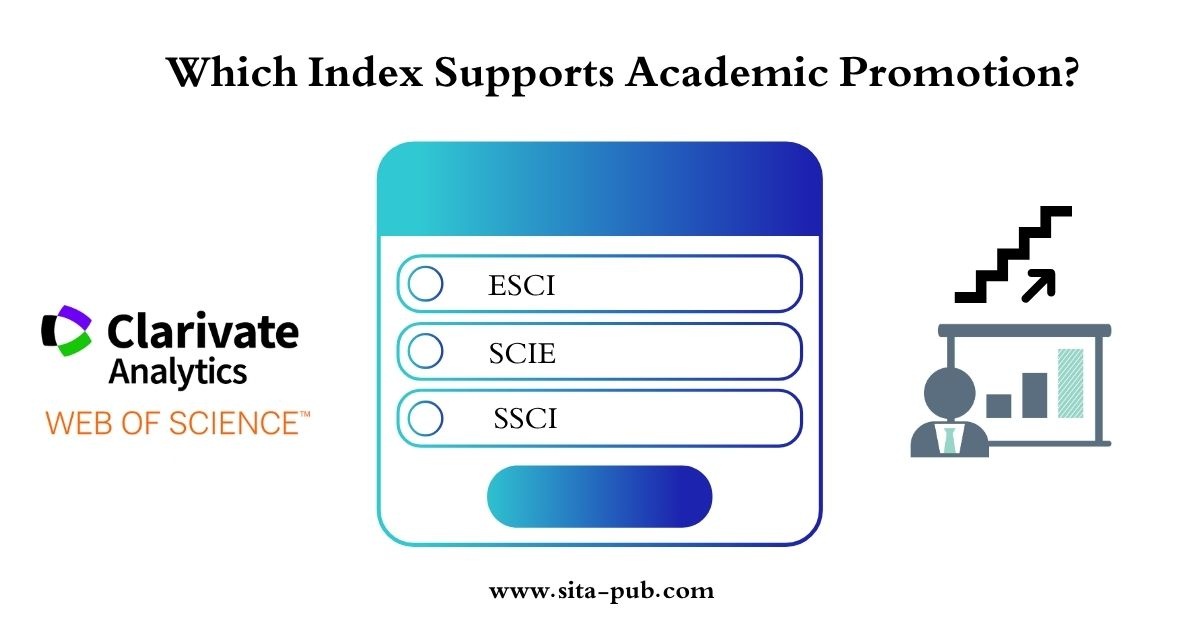ESCI vs SCIE vs SSCI: Which Index Supports Academic Promotion?


For researchers and faculty members aiming for academic promotion, the choice of journal index—whether ESCI, SCIE, or SSCI—can significantly impact their progress. These three indexes are part of the Web of Science (WoS) Core Collection, a widely recognized database of high-quality scholarly publications. While they are all curated by Clarivate Analytics, they serve different purposes, disciplines, and standards. Understanding the differences between these indexes will help researchers make informed decisions about where to publish their work.
The Web of Science Core Collection is a trusted platform used globally by academic institutions, ranking agencies, and researchers. It includes multiple citation indexes that cover a wide range of disciplines. Journals listed here are selected through a rigorous editorial evaluation, making them respected in academic circles.
The Core Collection includes:
Science Citation Index Expanded (SCIE)
Social Sciences Citation Index (SSCI)
Arts & Humanities Citation Index (AHCI)
Emerging Sources Citation Index (ESCI)

For the purposes of promotion and academic recognition, SCIE, SSCI, and ESCI are the most commonly discussed.
SCIE includes journals in the natural sciences, engineering, technology, medicine, and related fields. Journals listed in SCIE:
Undergo strict editorial evaluation.
Receive an Impact Factor (IF), which measures citation frequency.
Are ranked by quartiles (Q1–Q4), based on subject category.
Fields Covered: Biology, Chemistry, Engineering, Computer Science, Medicine, Environmental Science, and more.
Academic Value: SCIE journals are highly valued in most countries and universities for promotion, funding, and institutional rankings. Publishing in Q1 or Q2 journals within SCIE is often a requirement for senior academic positions.
SSCI focuses on journals in the social sciences. Like SCIE, it includes journals with a strong citation history and editorial rigor.
Journals in SSCI also receive an Impact Factor.
They are classified by quartiles based on discipline.
Fields Covered: Psychology, Economics, Education, Sociology, Political Science, Law, and related areas.
Academic Value: SSCI publications are often required for promotion in humanities and social science faculties. In many institutions, SSCI is equivalent to SCIE in terms of academic recognition.
ESCI was launched to provide coverage of emerging journals that meet basic publishing standards but may not yet have a strong citation track record.
No Impact Factor, but articles are still indexed and cited.
Considered a stepping stone to SCIE or SSCI.
Still part of the Web of Science Core Collection.
Fields Covered: Multidisciplinary – includes journals from all academic disciplines, especially newer or regional ones.
Academic Value: ESCI journals are widely accepted by many universities for early-career promotion, master’s or PhD graduation requirements, and project documentation. However, their acceptability varies depending on the institution or country.
Feature | SCIE | SSCI | ESCI |
|---|---|---|---|
Type | Science | Social Science | Emerging Multidisciplinary |
Impact Factor | Yes | Yes | No |
Quartile Ranking | Yes (Q1–Q4) | Yes (Q1–Q4) | No |
Academic Recognition | High | High | Moderate |
Coverage | Scientific Fields | Social Sciences | All Fields |
Evaluation Criteria | Strict | Strict | Moderate |

There is no universal answer. It depends on your:
University’s promotion policy
Country’s academic standards
Faculty or department
Research stage (PhD, Assistant Professor, etc.)

Generally:
SCIE and SSCI journals are preferred for senior-level promotion.
ESCI journals are often accepted for junior-level promotion or graduation.
Publishing in SCIE/SSCI journals is more competitive and takes longer.
ESCI journals are easier to access and publish in, but still respected in many cases.
Always check the official policy of your academic institution or ministry of education.
Index | Benefits | Challenges |
SCIE | High prestige, impact factor, widely recognized | Competitive, long review times, higher rejection rates |
SSCI | High prestige in social sciences, citation metrics | Limited number of journals, strict review |
ESCI | Faster publishing, easier acceptance, still reputable | No impact factor, may not be accepted everywhere |
When your research is still developing and you need early publications.
When your university accepts ESCI for graduation or promotion.
When you are targeting a regional or multidisciplinary audience.
When your paper’s scientific impact is solid, but not highly novel.
Publishing in ESCI is often a stepping stone to future publications in SCIE or SSCI.
Your research field greatly influences which index is suitable. For instance:
If you're in pharmacy, engineering, or medicine – SCIE is ideal.
If you're in education, economics, or psychology – SSCI is more relevant.
If your field is emerging or interdisciplinary – ESCI journals might offer more suitable platforms.
Always verify the index of the journal via the Web of Science Master Journal List.
Read your university's promotion policy to understand accepted indexes.
Consider your career stage—you don’t always need to aim for Q1 in your first publication.
Ensure your journal is not predatory—Web of Science journals undergo evaluation, but still be cautious.
Choosing between ESCI, SCIE, and SSCI depends on multiple factors including:
Institutional requirements
Your research quality
Discipline
Career goals
There is no “one size fits all.” Some researchers benefit from starting with ESCI and gradually moving to SCIE/SSCI. Others may need to target high-impact journals from the beginning. The most important step is to align your publication strategy with your academic goals and institutional policies.
Before submission, consult with your supervisor, university guidelines, or academic advisors.
Process of Submitting an Order in SITA Academy

Share Your Research Scope |

Receive Journal List |

Select Your Journal |

Formatting & Submission |